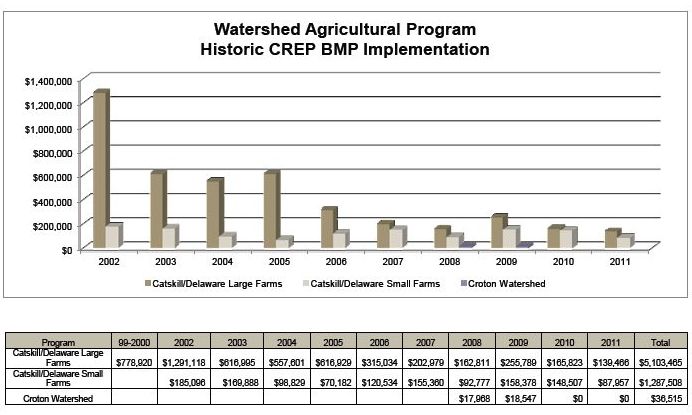CREP 2011 Accomplishments
USDA Conservation Reserve Enhancement Program (CREP) 2011 Accomplishments
Streamside vegetation, also known as riparian buffers, goes a long way to reducing streambank erosion, sedimentation and water turbidity. Couple those plantings with pro-active measures to fence animals out of streams and install alternative watering systems, and a low-cost solution to common on-farm water quality problems is put to work.
Add to these measures a financial incentive that rewards landowners for removing sensitive land close to streambanks out of production. This improved combination takes a land conservation approach to water quality to the bottom line by making the practice profitable for the landowner.
Recognizing simple measures in addressing water quality concerns on the farm, we’re taking CREP funding and matching it with NYC DEP funds to make this the most resourceful, common-sense practice in our Whole Farm Plan.
The USDA CREP Program within the NYC Watershed Agricultural Program utilizes the talents found within the multi-agency team assigned to work in the Watershed to promote, design and establish both Riparian Forest Buffers and Vegetative Buffers along watercourses. 2011 marked the 13th full year of the New York City Watershed Conservation Reserve Enhancement Program (CREP) Memorandum of Agreement between New York City, New York State and the United States Department of Agriculture (USDA). In 2011, seven Riparian Forest Buffer contracts (six new and one renewal) enrolled an additional 42.2 acres, increasing the total number of enrolled acres to 2,047.7.
| 2011 Total Implementation Expenditures | |
| Total Rental Payments (USDA) | $55,690 |
| Sign-Up Incentive Payment (SIP-FSA) | $ 3,890 |
| Practice Incentive Payment (PIP-FSA) | $80,640 |
| BMP Cost (FSA) | $51,519 |
| BMP Cost (WAP) | $51,519 |

